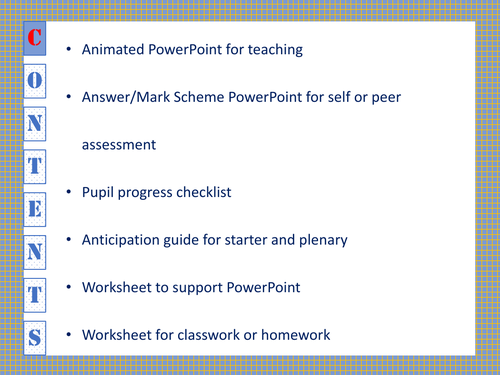





Using cake making to explain conservation of mass, the animated PowerPoint then demonstrates balancing equations using particle models and leads seamlessly into balancing equations with chemical formulae. The PowerPoint, which is accompanied by a worksheet, provides hints and tips on balancing equations, many animated worked examples and exercises. A further worksheet can be use as classwork or homework and this is supported by a second PowerPoint providing answers to enable easy self and peer assessment.
What’s Included
Animated PowerPoint
Answer PowerPoint
Pupils progress checklist
Anticipation guide for starter and plenary
Worksheet
Worksheet/homework
More high quality resources available here.
Elf Off the Shelf Resources
Get this resource as part of a bundle and save up to 29%
A bundle is a package of resources grouped together to teach a particular topic, or a series of lessons, in one place.
Elements to Equations - Three Fully Resourced Lessons KS3
Three fully resourced lessons taking the learner from an understanding of atoms and molecules through elements and compounds, chemical symbols and formulae and finally to naming compounds and balancing chemical equations. **What’s Covered** * All atoms of one element are the same but are different from the atoms of other elements. * Atoms combine to form molecules. * If combining atoms are from the same element, a molecule of an element is formed. * If combining atoms are from different element, a molecule of a compound is formed. * An element contains only one type of atom * A compound contains two or more different types of atom. * Elements are listed in the periodic table. * Each element has its own symbol. * Symbols can be the first letter of the name (capital), two letters from the name (capital then lowercase) or taken from the Latin name of the element. * The formula of a compound tells you how many atoms of each element are in it. * Working out the number of atoms of each element in a compound from its formula. * Naming compounds with the groups CO3, SO4, NO3. * Compounds containing only two atoms end in ide. * Mono = 1, di = 2, tri = 3. * Conservation of mass. * Balancing equations **What’s Included** * Animated PowerPoints for teaching with exit ticket quiz * Answer/mark scheme PowerPoints * Flip its (pupil writes questions to given answers) * Anticipation Guides (combined starter and plenary) * Foldables * Worksheets to support the PowerPoints * Fact sheets * Homework plus answers (x3) * Fact share worksheets * Pupil progress self-assessment checklists * Periodic table * Exit Ticket * Suggested lesson plans showing choices possible between resources Lots more resources at my shop? [Elf Off the Shelf Resources](https://www.tes.com/teaching-resources/shop/penyrheol1)
Elements to Balancing Chemical Equations - Three Fully Resourced Lessons Plus Revision Lesson and 7 Games KS3
Three fully resourced lessons taking the learner from an understanding of atoms and molecules through elements and compounds, chemical symbols and formulae and finally to naming compounds and balancing chemical equations. The review lesson is a useful pre-test toll which produces an individual review list for each pupil The versatile games pack can be used to reinforce each section of the current electricity module as it is taught or for revision. Many of the games could be used for cover lessons, even when taken by a non-specialist as they come with a hard-copy or PowerPoint of the answers. It is also the ideal end of term/year pack. **What’s Covered** * All atoms of one element are the same but are different from the atoms of other elements. * Atoms combine to form molecules. * If combining atoms are from the same element, a molecule of an element is formed. * If combining atoms are from different element, a molecule of a compound is formed. * An element contains only one type of atom * A compound contains two or more different types of atom. * Elements are listed in the periodic table. * Each element has its own symbol. * Symbols can be the first letter of the name (capital), two letters from the name (capital then lowercase) or taken from the Latin name of the element. * The formula of a compound tells you how many atoms of each element are in it. * Working out the number of atoms of each element in a compound from its formula. * Naming compounds with the groups CO3, SO4, NO3. * Compounds containing only two atoms end in ide. * Mono = 1, di = 2, tri = 3. * Conservation of mass. * Balancing equations **What’s Included – Teaching Materials and Printables** * Animated PowerPoints for teaching with exit ticket quiz * Answer/mark scheme PowerPoints * Flip its (pupil writes questions to given answers) * Anticipation Guides (combined starter and plenary) * Foldables * Worksheets to support the PowerPoints * Fact sheets * Homework plus answers (x3) * Fact share worksheets * Pupil progress self-assessment checklists * Periodic table * Exit Ticket * Suggested lesson plans showing choices possible between resources **Games Included** **Atoms and Molecules** * Find the Pair * Dominoes **Elements and Compounds** * Smart Board Bingo * Forces Board Game * Dominoes * Find the Pair * Save the School Librarian Escape Room More high quality resources available here. Elf Off the Shelf Resources
Something went wrong, please try again later.
This resource hasn't been reviewed yet
To ensure quality for our reviews, only customers who have purchased this resource can review it
Report this resourceto let us know if it violates our terms and conditions.
Our customer service team will review your report and will be in touch.